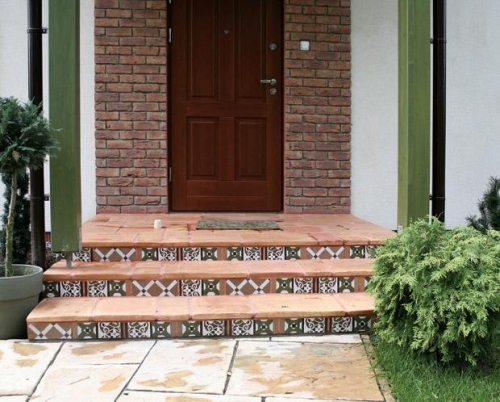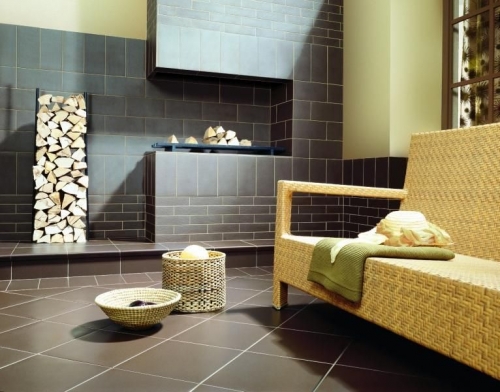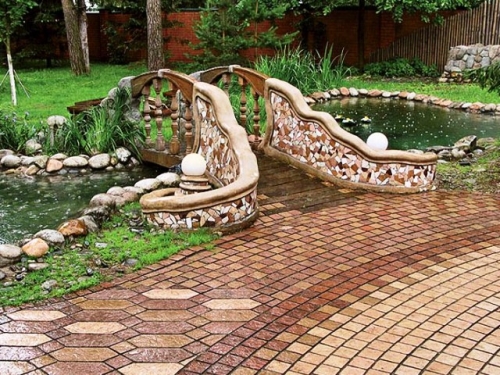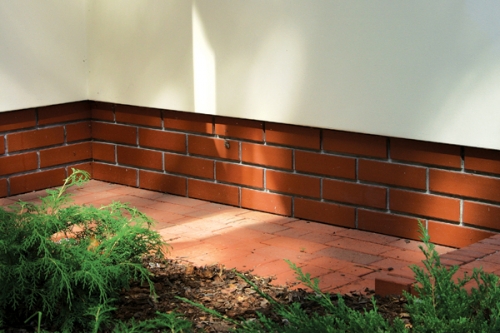The equipment of a modern bathroom is largely different from the standard one, to which everything ...
|
|
What can make you think about the installation of a new water supply? Morally and physically ... |
Recently, linoleum has gained more and more popularity. Now it is used ... |
Clinker tiles - from the origins to the present
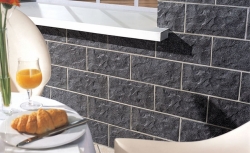
It happens that it is required to refresh or change the bored plastered facade of the building. For the most part, they plan to make the facade brick, but for understandable technical or financial reasons, it is difficult to do this. Therefore, during the reconstruction of the old house or designing a new building, you can faced the facade with thermal panels with clinker tiles to obtain many advantages. Among other things, the clinker has a wide range of colors and a significant variety of textures.
Table of contents:
- The history of the clinker
- Advantages of clinker tiles
- Production of clinker tiles
- Clinker production methods
- Types of clinker
- Application area
The history of the clinker
The word clinker has German roots, the material when tapping makes a characteristic sound Klink. For the first time, the Dutch came up with the clinker by developing a technology for the manufacture of high -strength ceramic stone. In Holland, at the beginning of the 19th century, the first clinker road was created, which connected Harlem with Amsterdam.
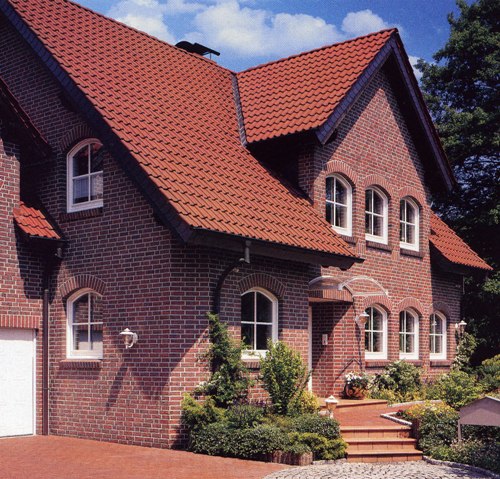
The Dutch over time began to produce a clinker for paving and construction of houses. Since in this country there are almost no natural stone materials, a new clinker tile for facades has gained popularity very quickly. The technology for the production of clinker from Holland spread to the neighboring countries of Western Europe, and then to America.
Advantages of clinker tiles
The clinker is a clay -based ceramic tile, which has passed at high temperature long -term heat treatment. The clinker for a long time was made in Germany from clay of a special variety. The distinctive feature of the clinker lies in the fact that it is made on the basis of natural material and has a low level of moisture absorption - from 0.3 - 3%, which makes the tile with frost -resistant.
Due to its special strength, the material has high flush rates, which makes clinker tiles popular in places of public use with significant patency of people. The clinker is not subjected to mechanical influences, it is resistant to sunlight, mold, bacteria, fungus, moss and aggressive substances. Tiles are produced at a temperature of more than 1000 degrees Celsius, and thanks to this technology, various inclusions and voids are completely excluded from it.
Today, clinker tiles in assortment and quality are not inferior to universally recognized brick for facades. At the same time, the clinker can significantly save, since the use of full -format brick in some cases is very expensive, inappropriate or impossible. Clinker tiles for brick is an excellent solution in the construction of a new house and reconstruction of old buildings.
Production of clinker tiles
For the production of high -quality facing clinker tiles, refractory shale clay of a particular chemical composition are used, which do not contain impurities of calcium and salt carbonate. In addition to chamotte and flux, it is customary to add a thin -band promoter to the finished screen, which accelerates the sintering procedure.
The clinker firing is carried out at high temperatures close to 1300 degrees Celsius, although this temperature for ordinary ceramic products does not exceed 1000 degrees. Such a technique allows you to get the material of a microthetic structure without voids, a product of high strength and low water absorption. And this, in turn, is very important for our climatic conditions.
Schikhta often add dyes that allow you to make facade clinker tiles of a wide variety of colors from dark brown to milky white. This allows you to design and create original facades with different color and plastic solutions. However, clinker tiles, even without adding dyes, have beautiful tones of yellow-brown range, which depends on the chemical composition of the clay used and its firing temperatures.
Clinker production methods
At modern enterprises, the clinker is made by an extrusion method. For this, a small amount of water is added to the charge for this, and the resulting pastry mass under the influence of the mandsteus matrix is \u200b\u200bpushed through a punch, which has a rectangular hole with dimensions, which set the necessary thickness (9,17 millimeters) and width (50 - 113 millimeters). A tape cut by a thin wire in length (193 - 295 millimeters) comes out of the extruder, and the resulting blanks enter the furnace for firing.
But, along with this, there is a manual molding technique that allows you to get exclusive clinker tiles, which can be used in external decoration of houses under construction and restoration of historical buildings facades. In the latter case, artificial aging of clinker tiles is used, the surface of which has chips, shells, scuffs formed with compressed air and water jet under high pressure.
Types of clinker
The clinker is a unique building material that has such properties that no variety of ceramic tiles can compare with. Clinker tiles, as a rule, have standard dimensions of 12 by 24.5 centimeters, but it is also square, and large enough. The thickness of the clinker changes from 9 to 25 millimeters. With increasing thickness, the strength of clinker tiles increases, which can easily serve as a false floor.
The color scheme of clinker tiles has about 100 different options - from cream and white tones to red -brown and black. On the colors of the clinker, it is worth stopping separately. Clinker tiles are natural material without chemical additives and dyes, so it does not change its own color and does not burn out after many years in the sun. The widest range of colors is achieved only by natural methods.
The surface of the clinker and clinker tiles under the brick is rough, glossy, matte or unprocessed. To achieve the effect of burned material, they impress coal into raw materials, and to improve decorative properties, they apply a special glaze. A natural dye is applied to the unbroken clay to give the necessary color, which is baked simultaneously with tiles. Also, the clinker is glazed.
As building and finishing material, clinker tiles have the following varieties: facing material for internal and external decoration of buildings, as well as technical clinker tiles for paving pedestrian paths, roads, floors in public and industrial buildings, as well as for decoration of storage facilities.
Application area
The scope of clinker tiles is very wide, and thanks to frost resistance, the clinker is used in all climatic zones. Clinker tiles are suitable for low -rise construction and construction of multi -storey buildings, and is also used to increase the technical properties of existing residential buildings. The clinker is suitable for facing concrete, frame, foam concrete and wooden surfaces.
In this case, a layer of insulation is attached to the outside of the outer wall, on top of which clinker tiles are laid, after which the heat -insulating ability of the enclosing structures increases significantly. Clinker tiles increase the durability of the facades: they are not destroyed under the influence of aggressive substances that are contained in soot, smog and acid rains.
Due to its features, clinker tiles are widely used in suburban housing construction. With the help of this material, terraces, open areas, balconies, greenhouses, garden paths and courtyards are equipped. Clinker tiles allows you to create original landscape options, since it is resistant to the influence of all kinds of atmospheric phenomena, does not rot and does not burn, is not interesting to insects and fungi, and also perfectly retains color.
The clinker is indispensable for pools due to its durability. Various monolithic plums of complex configuration, special grooves for convenient hand capture, corner elements, a rough surface in places where there is a danger of slipping. The floor in the garage can also be made of this tile, because the material is characterized by high chemical resistance and it is not terrible oil and gasoline.
Very often, clinker tiles are used as an alternative to expensive analogues - natural stone or ceramic granite. In the decoration of stairs, facades, pedestrian clinker tiles, and only in public places with high operational loads (airports, stations, metro) it makes sense to use ceramic granite instead.
Consumest such material when facing fireplaces. Clinker tiles look like a brick, but has resistance to high temperatures, so it is ideal for furnaces arranging. The uniqueness of the clinker is the widest selection of color colors. Clinker tiles are also available in a fairly popular version - under manual molding. The finishing of clinker tiles gives the fireplane the effect of antiquity and will create a mysterious interior.
As you already understood, the sandy and rough surface of the clinker tile resembles a classic Dutch brick. But such an optical component is far from the only advantage of this quality material that has passed the process of firing in the tunnel furnace. The clinker will provide you with complete comfort and comfort, and will also exclude additional financial costs.


